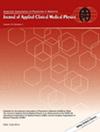Effects of simultaneous multislice acceleration on the stability of radiomics features in parametric maps of IVIM and DKI in uterine cervical cancer
Abstract
Purpose
The aim of this study was to investigate the influence of the simultaneous multislice acceleration (SMS) technique as well as two-dimensional (2D) and three-dimensional (3D) tumor segmentations on radiomics features (RFs) within the parametric maps of cervical cancer, which were computed by intravoxel incoherent motion (IVIM) and diffusion kurtosis imaging (DKI). Additionally, the study sought to identify those RFs that could characterize the clinical stages (low-stage vs. high-stage) of cervical cancer.
Materials and methods
Multi-b-value diffusion-weighted imaging (DWI) of 40 patients with cervical cancer were collected using the SMS technique with acceleration factors (AF) of 1–3. RFs were extracted from parametric maps representing pure diffusion coefficient (D), pseudodiffusion coefficient (D*), perfusion fraction (f), mean diffusivity (MD), and mean kurtosis (MK). A total of 93 2D and 93 3D RFs were extracted from per parametric map. The concordance correlation coefficient (CCC) and coefficients of variation (COV) were used to jointly assess the stability of features. Finally, the intra-class correlation coefficient (ICC) was used for intra-group consistency assessment. Receiver operating characteristic (ROC) curve was used to evaluate diagnostic performance of stable features in distinguishing lower and higher stages.
Results
Feature stability decreased with higher AF. Among these features, 9.1% of 2D and 12.7% of 3D RFs were stable (CCC > 0.9 and COV ≤ 0.1). ADC maps had the highest stability, whileas D* and f maps had the lowest stability and 3D features were more stable than 2D features. A total of 5 2D and 25 3D stable features were identified that could distinguish lower and higher stages (AUC = 0.66–0.83).
Conclusion
SMS demonstrated impact on the stability of RFs in IVIM and DKI parametric maps, particularly for D* and f maps. Multi-b-value DWI with SMS (AF = 2) was recommended for clinical radiomics research.


 求助内容:
求助内容: 应助结果提醒方式:
应助结果提醒方式:


